See also
- Kokufu, the capitals of the historical Provinces of Japan
- Kokufu-Tagajō Station, Tagajō, Miyagi Prefecture, Japan
Kokofu is a town in the Ashanti Region of Ghana.
Kokofu may also refer to:

Emperor Go-Murakami was the 97th emperor of Japan, according to the traditional order of succession, and a member of the Southern Court during the Nanboku-chō period of rival courts. He reigned from September 18, 1339, until March 29, 1368. His personal name was Noriyoshi (義良). He reigned from Sumiyoshi, Ōsaka, Yoshino, Nara, and other temporary locations.
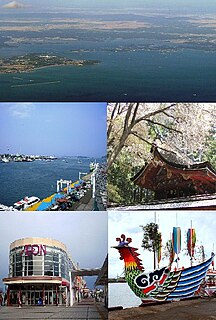
Shiogama is a city located in Miyagi Prefecture, Japan. As of 1 June 2019, the city had an estimated population of 52,662, and a population density of 3,032 persons per km² in 23,270 households. The total area of the city is 17.37 square kilometres (6.71 sq mi).

Tagajō is a city located in Miyagi Prefecture, Japan. As of 1 June 2020, the city had an estimated population of 62,869 in 27,869 households, and a population density of 3,200 people per km². The total area of the city is 19.64 square kilometres (7.58 sq mi). The city was named after Taga Castle, the capital of Mutsu Province from the Nara period.
Fuchū (府中) is the name of several places in Japan.
Kokufu was a town located in Iwami District, Tottori Prefecture, Japan.
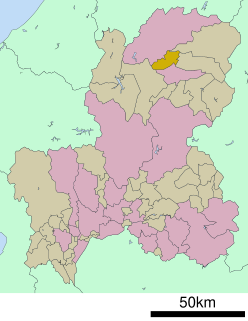
Kokufu was a town located in Yoshiki District, Gifu Prefecture, Japan.
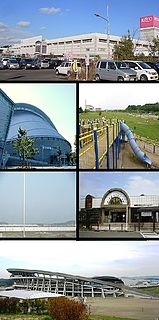
Rifu is a town located in Miyagi Prefecture, Japan. As of 1 June 2020, the town had an estimated population of 36,014, and a population density of 800 persons per km2 in 13,568 households. The total area of the town is 44.89 square kilometres (17.33 sq mi). Rifu is known for its nashi pears. Recently, wine and candy made from nashi pears have been developed in the town.

The Senseki Line is a railway line in Miyagi Prefecture, Japan, owned and operated by the East Japan Railway Company. It connects Aoba-dōri Station in Sendai to Ishinomaki Station in Ishinomaki, and provides access to the central coast areas of Miyagi Prefecture, significantly the Matsushima area. It connects with the Sendai Subway Nanboku Line at Aoba-dōri Station; the Tōhoku Shinkansen, the Tōhoku Main Line and the Senzan Line at Sendai Station; and the Ishinomaki Line in Ishinomaki. The name Senseki (仙石) comes from the combination of the first kanji of Sendai (仙台) and Ishinomaki (石巻), the two cities that the Senseki Line connects. It is also the only line in Sendai area that is powered by DC overhead power line.

Miyagino-ku (宮城野区) is the northeastern ward of the city Sendai, in Miyagi Prefecture, Japan. As of 1 July 2017, the ward had a population of 196,086 and a population density of 3370 persons per km2 in 91322 households. The total area of the ward was 58.19 square kilometres (22.47 sq mi).

Geba Station is a railway station in the city of Tagajō, Miyagi Prefecture, Japan, operated by East Japan Railway Company.
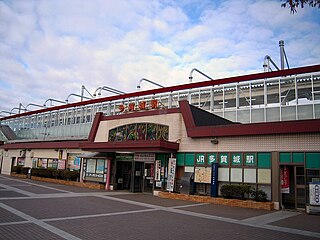
Tagajō Station is a railway station in the city of Tagajō, Miyagi Prefecture, Japan, operated by East Japan Railway Company.

Kokufu-Tagajō Station is a railway station in the city of Tagajō, Miyagi Prefecture, Japan, operated by East Japan Railway Company.

Rikuzen-Sannō Station is a railway station in the city of Tagajō, Miyagi, Japan, operated by East Japan Railway Company.
Kokufu Station is a railway station in Toyooka, Hyōgo Prefecture, Japan.

Hida-Kokufu Station is a railway station on the Takayama Main Line in the city of Takayama, Gifu Prefecture, Japan, operated by Central Japan Railway Company.

Taga Castle was a jōsaku-style Japanese castle built in the late Nara period in what is now part of the city of Tagajō in Miyagi prefecture in the Tōhoku region of far northern Honshu, Japan. Bashō tells of his visit to the site in Oku no Hosomichi. The ruins of Taga-jō and its former temple have been designated a Special Historic Site (特別史跡) since 1922.

The Tōhoku History Museum is a museum in Tagajō, Miyagi Prefecture, Japan. It houses finds from excavations at the site of Tagajō as well as from other archaeological sites in the Tōhoku region of northern Japan.
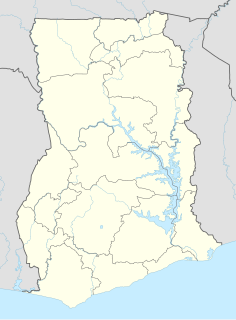
Kokofu is a town in the Bekwai Municipal district, a district in the Ashanti Region of Ghana.
Geba may mean: